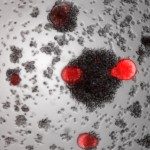Link to Pubmed [PMID] – 11558262
Bioorg. Khim. 2001 Jul-Aug;27(4):282-90
Translation initiation in Escherichia coli involves as a rule complementary interactions between a Shine-Dalgarno (SD) sequence upstream of the initiation codon and a highly conserved 3′-end sequence of 16S rRNA (anti-SD). The translation efficiency is believed to be directly affected by the affinity of the ribosome to the mRNA initiation region. Earlier, high-affinity RNA ligands to E. coli ribosomes were selected by the SELEX approach, with the ligands containing an extended SD-sequence well represented. In this work, we examined the ability of artificial ribosome binding sites (RBSs) containing such an extended (10-nt) SD-sequence (superSD) to drive translation in vivo, as well as its ability to form the translation initiation complex in vitro. Toe print experiments showed the formation of a ternary initiation complex on mRNA comprising superSD. Moreover, they proved the formation of an extended SD-duplex in the binary 30S-mRNA complex. Nevertheless, the superSD appeared to be inefficient in translation in vivo. We believe that the initiation complex involving a superSD-element is too stable to be functional; it may impede the transition from initiation to elongation, thus disrupting the transcription-translation coupling and inhibiting the formation of polysomes.

